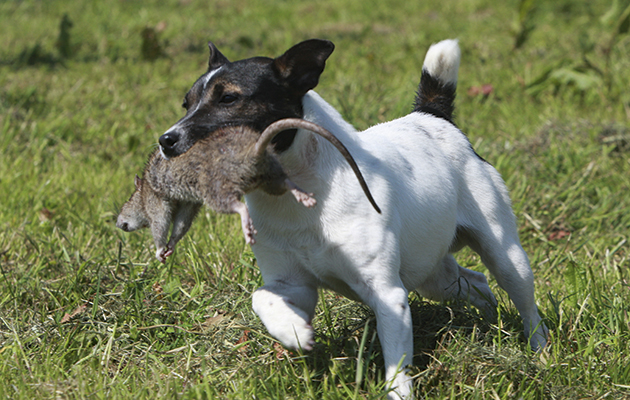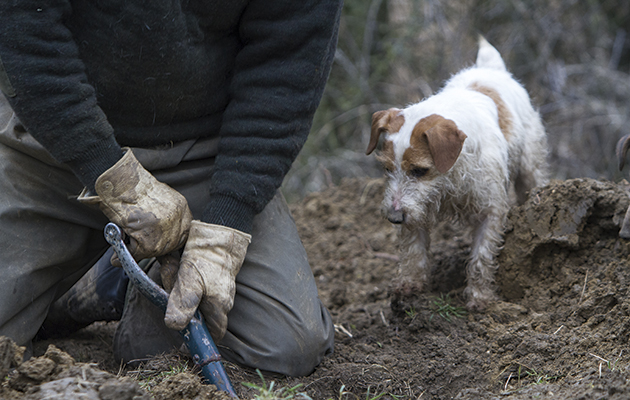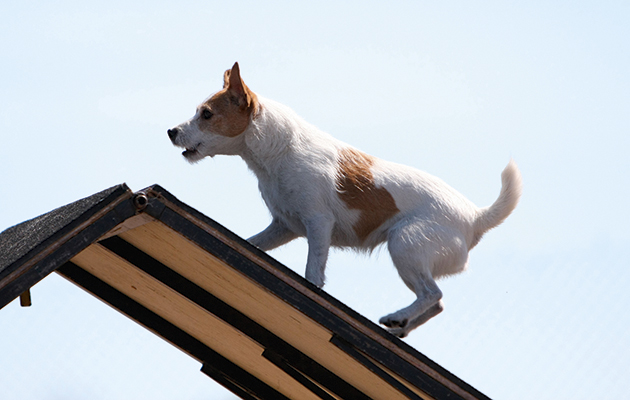Preserve the Jack Russell from the interests of the Kennel Club, says David Tomlinson. The last thing our JRTs need is “recognition” as a pedigree breed and showring breed standards
Jack Russell Terriers have been long and much loved by the sporting world for being the feistiest little working dog. But with the Kennel Club recognising them as a pedigree breed, must we fear for their future?
Do you have a puppy to train? Read gundog puppy schools: training your pup for our expert advice.
THE JACK RUSSELL
A pedigree Jack Russell? You cannot be serious! That’s the reaction of most Jack Russell terrier owners I have spoken to about the Kennel Club’s recent recognition of this most feisty and diverse of dog breeds, founded by the Rev’d John (Jack) Russell, vicar of Swimbridge in North Devon. Known as the sporting parson because of his love of the chase, Russell’s sermons were reputedly short by Victorian standards, as his hunter was usually saddled and waiting in the churchyard. Starting with his foundation bitch, Trump, he succeeded in establishing a tenacious and feisty strain of terrier that could not only run with the hounds but pursue foxes underground with great success.
Russell bought Trump from a milkman in Oxford, where he was studying, in 1815. He brought her to Devon, where, with careful breeding, he established what is today one of our oldest sporting breeds. Its success and
longevity is easily explained. Lack of breed purity is one of the strengths of the Jack Russell, as over the decades its genes have been mixed with those of many breeds, from border terriers to patterdales, perhaps even a hint of whippet or staffie. Such mixing of blood has helped maintain the Jack Russell as a real working terrier, with proper terrier instincts.
As a result, the modern Jack Russell has lost none of their enthusiasm for ratting or even terrorising the neighbours’ cat. They may be small but they have big personalities. While your average spaniel will think twice before mixing with a pack of foxhounds, a Jack Russell thinks nothing of it. They are also delightfully variable. Some are broken-coated, others are smooth, some are short-legged, others have long legs. One thing that they have in common is a white coat with tan or black markings. Other than that, almost anything goes, but not for much longer if the Kennel Club has anything to do with it.
THE JACK RUSSELL AND THE KENNEL CLUB
The Kennel Club has been eyeing up the Jack Russell for many years, anxious to include it within its pedigree-dog empire. It had a minor success in bagging the Parson Jack Russell – a long-legged first cousin of the standard Jack Russell – back in 1990, but the bigger prize eluded it. In 2002 the journal Our Dogs reported that the Kennel Club was considering recognising the Jack Russell but there was considerable confusion with the Australian Jack Russell, a breed recognised by the FCI (Fédération Cynologique Internationale) but deemed by JR enthusiasts as not a proper Jack Russell at all. What the Kennel Club was after was the shorter-legged versions of the Parsons it had already acquired.
It took another 13 years to finalise proposals but at the start of this year the Jack Russell became a Kennel Club-recognised breed. According to the Kennel Club, recognition will “protect the heritage of this popular dog, and help prospective dog owners who are choosing which dog is most suited to their lifestyle”. The Kennel Club is poised to produce a breed standard, describing “the various characteristics of the breed and how they are likely to be in terms of their size, exercise, temperament and grooming needs”. As a result, a terrier that likes nothing better than disappearing down foxholes will be eligible to sit on the benches at Crufts. The Kennel Club believes that a further bonus of recognition will be helping to “promote the responsible breeding of Jack Russells and ensure that the level of predictability seen in other recognised dog breeds is duplicated in registered Jack Russell terriers”.
The fact that the Jack Russell has retained its character, its looks and its health for the best part of 200 years without any help from the Kennel Club seems to have been overlooked. Not surprisingly, the Jack Russell Terrier Club of Great Britain (JRTCGB ) is outraged at this blatant takeover of its breed, pointing out that for “40 years it has stood against Kennel Club recognition for the Jack Russell terrier and will always do so”. War has been declared, with the JRTCGB website proclaiming: “Our terriers, worldwide, are classy, correct in conformation and possess a tremendous working ability. They are virtually free of both hereditary and congenital defects while among the Kennel Club breeds these are rife. The Kennel Club is about to embark on a journey into a minefield of confusion, misery and failure.”
THE EFFECT OF PEDIGREE RECOGNITION
JRTCGB chairman Greg Mousley says that his club “fought tooth and nail against the recognition of the Parson Jack Russell Terrier but the Kennel Club committee blindly went ahead. Now many years later they have realised their predicted failure and Parson Russells are almost as rare as the breed the Kennel Club started with in 1860, the Fox Terrier.”
Mousley doubts whether Kennel Club recognition “will affect the real Jack Russell terriers that are under our care. The Parson Russell came and has almost left. This ridiculous attempt will also fail and pass. The JRTCGB along with its affiliated JRT Clubs worldwide has a huge register of quality Jack Russell terriers dating back to the mid Seventies. Our registration system is carefully structured to prevent any Kennel Club pollution. We have a breed standard that is totally work related and practical.”
He also pours scorn on the Kennel Club’s claim that recognition of the Jack Russell will protect its future. “The Kennel Club has never cemented the heritage nor protected the future of any of the breeds under its banner. Quite the opposite. Take for example the poor old English bulldog – it has been protected to the point where natural reproduction is impossible. Our worldwide aim is to protect, preserve and work the Jack Russell terrier. We have held firm against the Parson Russell and succeeded. The same resilience will hold firm again.”
Jack Russells have been exported widely but even so it comes as something of a surprise to find that the Jack Russell Terrier Club of America (JRTCA ) is the largest JR breed club in the world. Like its British counterpart, it is fiercely opposed to official recognition for the breed, saying: “It is the opinion of the JRTCA that an attempt to standardize the Jack Russell is a dangerous step towards the deterioration of this terrier as the unique, versatile working terrier we know today.”
WORKING DOGS BREEDS MUST WORK
Jemima Harrison, whose BBC documentary Pedigree Dogs Exposed shook the Kennel Club to its foundations in 2008, admitted “feeling struck by an uncommon melancholy” when she heard of the plan. It motivated her to launch an online petition asking the Kennel Club to reverse its decision. She pointed out that “the Reverend Jack Russell, after whom the breed is named, was a fierce opponent of dog shows and did not register his own terriers, describing them as: ‘differing from the present show dogs as the wild eglantine differs from a garden rose’.” The petition attracted close to a thousand supporters but was ignored by the Kennel Club.
Patrick Burns, who writes a widely read blog under the name Terrierman, pointed out “that you cannot protect and preserve working dogs without working them. People who think otherwise are kidding themselves. They are the reason every working-dog breed dragged into the Kennel Club has been ruined there. These people sincerely believe that if they breed a dog that looks the part, it can do the part. But this misguided belief underscores their ignorance. What makes working breeds special is not what is on their outside but what is on their inside.”
Harrison agrees. “The Kennel Club doesn’t award rosettes for work. The dogs are judged for trotting round a showring. The Jack Russell in the UK has managed perfectly well without the Kennel Club’s help and its great strength is its diversity – in looks and genetically. ” She goes on to point out that the Westie (West Highland white terrier) was “once a scruffy, game little dog, but has suffered terribly under KC-recognition. Today it’s a real shadow of its former self; beset with immune problems, including the often intractable Westie itch – a skin condition sometimes so severe that the dogs have to be euthanised.”
A FINANCIAL ADVANTAGE
It will certainly be to the Kennel Club’s financial advantage to recognise the Jack Russell. Probably well in excess of 10,000 Jack Russell puppies are born in the UK every year. If half of these were to be registered it would raise around £80,000 (it currently costs £16 to register a puppy). In recent years the Kennel Club’s income from registrations has been falling due to the growing popularity of cross breeds, such as labradoodles and cockerpoos.
The JRTCGB has its own breed standard and registration system: a fiver per puppy or a litter for £15. Its breed standard is unlike any other I’ve read. There are a few basics, such as the dog must be 50% white; and “in solid, hard condition”. The tail “should be set rather high and carried gaily” and should provide a good hand-hold if the dog needs to be removed from an earth. Judges should note that “old scars or injuries, the result of work or accident, should not be allowed to prejudice a terrier’s chance in the showring unless they interfere with its movement or with its utility for work or stud”.
Terrier shows are well supported by working terrier enthusiasts. The JRTCGB also stages regional shows, with the winners qualifying for the National Federation of Working Terriers Champion of Champions show. This year’s Champion of Champions show will be held at the Midland Game Fair on 18 September.
It would be fascinating to know what Parson Russell would have made of this. Despite his dislike of dog shows, he was, apparently, a founding member of the Kennel Club.











